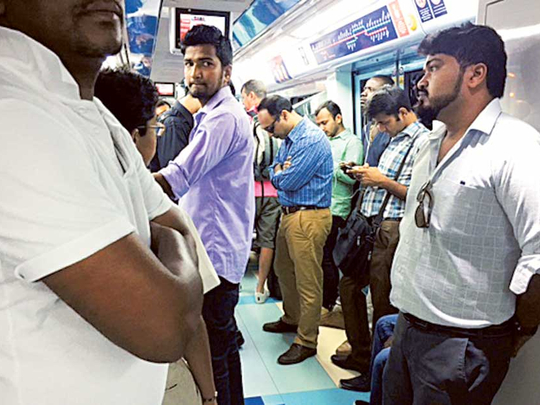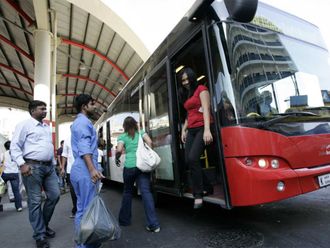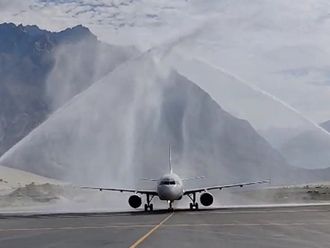
Dubai: Dubai Metro trains are now running more frequently throughout the week both on the Red and Green lines, following adjustments made to the operations. The move comes in response to the growing demand, leading to congestion in the trains.
Crowding, particularly during peak hours in the morning and evening, is common, forcing passengers to skip trains due to lack of space.
The rearrangement of train frequency was done last week as an attempt by the Roads and Transport Authority (RTA) to help create more space on trains.
“Rail operations department regularly monitors the ridership and crowding in the trains and improves the timetable and services after all required conditions are satisfied,” said Mohammad Yousuf Al Mudharreb, director, Rail Operations at RTA’s Rail Agency.
He added that the train frequency was decided after thorough study of ridership patterns.
On the Red Line, between 6.15am and 6.30am the frequency of trains heading towards UAE Exchange has been doubled from a train every five minutes and 16 seconds to every two minutes 38 seconds.
This will mean three extra trips running during this period.
Similarly, on the return journey between 4pm and 4.30pm, the trains are now running every two minutes 38 seconds instead of every four minutes.
Several other adjustments have been made in both directions to ensure 154 additional trips on the Red Line, while 122 more trips are also running on the Green Line.
The increase in frequency is in addition to several short trips launched along busier segments of the Red Line last Sunday. The short trips are in operation during the busiest hours of the morning service.
With only half or a portion of the total route to cover, short trips will have quicker turnaround time, giving commuters more options.
Al Mudharreb explained that the trains on short trips stop at all stations along its chosen segment.
“A short trip runs as a normal trip, stopping at all station on its route. Only difference is that it starts from an en route station,” said Al Mudharreb.
Explaining further, he said: “A normal trip runs from Rashidiya to UAE Exchange and vice versa, while these short trips start from an en route station, for example, Dubai Internet City station and runs as normal trip towards Rashidiya.”
The trains running on short trips will not be any different than those on the regular trips and Mudharreb said that there won’t be any need to identify the trains for the commuters.
“Commuters do not require to identify the train, for the customers waiting in between the station where the trips starts from to the terminal station or vice versa, it will be just like a normal service,” he said.
Dubai Metro also runs express services between 5.30am and 5.50am on either side of the Red Line. Express trains skip a few stations in between and stop only at major stations in order to cut down on journey time from one end to another.
More than 512,000 people commute by Dubai Metro every day, using both the Red and Green lines.
Fifty-five trains operate on the Red Line daily, carrying 24,229 passengers per hour during morning peak hours and 33,036 passengers per hour during evening peak hours.
On the Green Line, the peak hour traffic is much less with 15,565 passengers per hour travelling during morning peak hours and 12,682 passengers per hour during evening peak hours, carried by 17 trains.
The trains make 5,626 trips throughout the week on both the lines, with Thursday being the busiest, witnessing 964 trips.
From Sunday to Wednesday, the metro runs 845 trips each day, while on Fridays and Saturdays trains run 567 and 715 times respectively.
Meanwhile, Dubai Metro along with Dubai Tram and other means of smart mobility has helped reduce millions in tonnes of CO2.
Last year the metro reduced 300,600 tonnes of CO2 emissions, while Dubai Tram reduced 2,800 tonnes of CO2 during the same period.
Vox Pop
Mohammad Sufair, Indian
“I find the service during mornings and afternoons are better, but the evening rush is quite bad. Sometimes it is so bad that many of us prefer taking a bus from Jebel Ali to Al Karama. I find the bus more convenient and stress-free than the metro. I think it is a good move to introduce short trips and more regular trips but I request RTA to add more trains in the evening when the demand is highest.”
Ilyas Aung Myat Moe, Myanmar
“I use metro every day for all work as well as for other purposes. For me this is the best option. The service is excellent, of course there is arush but my journey is very short so it doesn’t affect me much. With improved frequency I think the service is much better.”
Noris Beldia, Filipina
“Rush-hour congestion is normal for all metro services in most of the big cities. Yes, there are congestion issues, but I find the service is much better than I have experienced in other places. The main is issue is congestion in the evening. Sometimes I need to skip a train or two before I find space. More trips will definitely solve the problem.”












